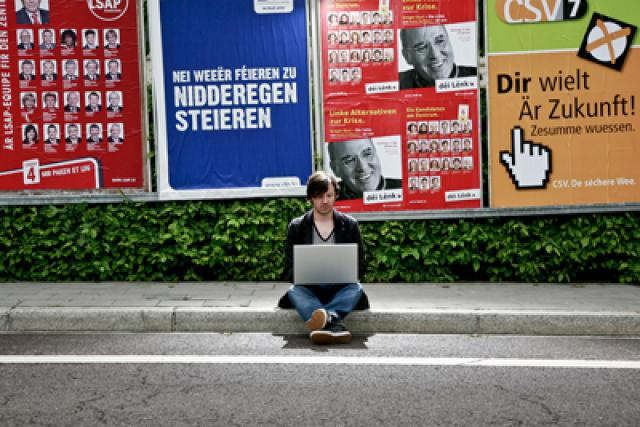“Five years ago, new media was just a side-show,” says Romain Schneider, general secretary of the LSAP socialist party. Speaking at a presentation of the party’s election website, Schneider highlights the innovations the LSAP has introduced to the 2009 campaign – as well as an interactive candidate carousel that allows visitors to the site to pick out mini-biographies of candidates in their electoral constituency, an online calendar of election events and series of short films explain the party’s policy on a number of issues. The LSAP is certainly taking the internet seriously this time around, and Schneider clearly thinks new media could be used to sway some sections of the electorate, particularly younger and first-time voters. “E-campaigning five years ago was not used enough and had no influence over the outcome,” he says. “In 2004 only seven candidates had their own website, for example. This year the majority have some form of presence on the internet.”
The socialists are not alone, of course. Of the eight parties putting up lists for the elections, only those with the most limited budgets, the communist KPL and the BiergerLescht (a breakaway led by former ADR deputy Aly Jaerling), have retained static, non-interactive websites. The other six have all incorporated videos as well as a variety of other downloadable and interactive material such as photo galleries, maps with lists of candidates for each of the four constituencies, electoral manifestos, FAQs, postal voting application forms and agendas. Many of the videos are uploaded onto YouTube. While most, like the LSAP, feature direct speeches from candidates and party officials on the broad issues of policy, the CSV has chosen a series of short sketches featuring two “average” voters discussing more specific themes such as the recent debate over entry level salaries for civil servants or the call for a referendum on the constitutional change stripping the Grand Duke of certain powers. The CSV has also ensured its election website is accessible via iPhone.
Social networking
The CSV website also provides a link to its Facebook page – a presence on the social networking site seems to be de rigeur for the major political parties, even though active membership of their pages is limited to numbers in the hundreds rather than thousands. The LSAP again seems to lead the way with the most members and a wide variety of sites for different constituencies and candidates. The CSV, ADR, Dei Gréng and the DP also all have their own pages – the DP even has a special elections ’09 page. If the thinking behind the move to Facebook is to encourage young voters to become more active in political life, it seems to have worked. Mateusz Buraczyk, a young Luxembourger from Pétange, for example, has created a Facebook site calling for an LSAP-DP-Dei Gréng coalition to emerge from the election and has attracted some 92 members.
New media is not just being used by the political parties. The Polux research programme at the University of Luxembourg, led by Dr. Philippe Poirier, has launched a new service for voters. Smartvote is a collaborative effort with the Politools-Political Research Network based at the University of Bern in Switzerland. The researchers built up a database on the views of some 111 (26%) candidates and nearly all parties in the forthcoming elections using an online questionnaire to profile their views. Voters visiting the smartvote.lu site can now answer a similar questionnaire and provide further details about the importance they give to different policy areas. Once processed, the results help identify the candidates and parties that most closely share their own political views – though the website adds an important disclaimer that the results should in no way be construed by voters as a recommendation. Voters who do not want to trawl through the questionnaire can use the site’s “smartmap” to find the position of a particular party or candidate on a two-dimensional axis, placing them between cultural liberalism and conservatism and between left-wing or right-wing socio-economic policies. And another new website, politikercheck.lu, allows voters to ask individual candidates in their constituency specific questions in three easy steps. Run by private members as a non-profit organization – PolitikerCheck.lu asbl – the website is based on similar schemes that operate in Germany, Austria and Ireland.
